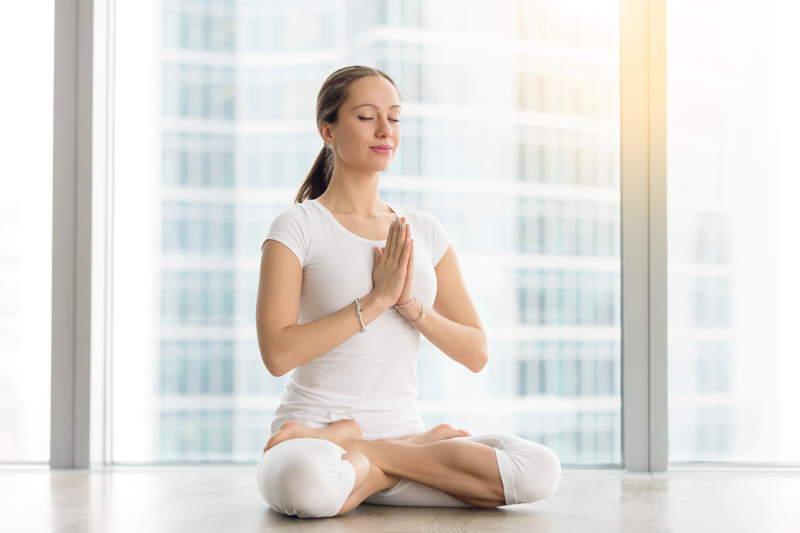Thinking about taking up yoga? You’re in the right place. In this guide, we go through everything from what you need to get started to the best yoga poses for beginners. This is the guide to yoga we wish we had growing up. By the end of this article, you’ll be ready to grab your yoga mat and head to your first class.
What You Need
First things first, let’s discuss what you need to get started. Whether you’re planning to practice independently or attend a studio class, there are a few things you’ll need before you can begin. One of the most important accessories is a good quality yoga mat. While some classes have communal mats, many practitioners prefer to bring their own. Taking your own mat will ensure you don’t miss out if there aren’t enough communal mats for everybody, and they’re also way more hygienic than a shared mat. If the yogi before you is recovering from a cold, he could easily pass his germs onto the mat. If you then use said mat, there’s a chance of you picking up whatever he has.
The next thing to consider is your clothing. Most women wear yoga pants and a fitted top while men opt for sweatpants or yoga shorts. With pants or shorts, invest in a pair that won’t fall down or ride up too high when you move. You should also keep movement in mind when choosing a top. To stay covered during the class, go for a longer top that doesn’t move too much as you perform asanas.
The final thing to think about it props. While props aren’t essential, they can be highly beneficial for beginners – particularly if you have any physical limitations. Before your first class, you may want to pick up a yoga block, yoga strap, and a yoga blanket. Your instructor can then show you how to use them during asana practice.
Key Benefits
Wondering what the benefits of yoga are? Below, we explore some of the main ones.
Increases Strength and Flexibility
One of the key physical benefits of yoga is increased strength and flexibility. While weight training has its benefits, yoga can also be used to build your strength. Known as bodyweight training, yoga uses your body weight as resistance to build strength. Not only does this keep equipment to a minimum, but it also provides a balanced workout instead of concentrating on a single area. At the gym, most machines target one muscle group. While this can help to build strength quicker, it can make you look out-of-proportion if you don’t properly manage it. You don’t have to worry about this with yoga. Engaging multiple muscle groups simultaneously, yoga provides an all-over body workout that builds strength and flexibility.
Decreases Stress and Anxiety
In the busyness of modern life, elevated stress levels are common. If left untreated, this can affect your day to day life and eventually lead to burn out. Thankfully, yoga is a great way to lower your stress levels and allow your body to unwind after a hectic day.
Tones the Muscles
When practiced regularly, yoga also helps the muscles to become leaner and more defined. Unlike a gym session, bodyweight training doesn’t place excessive stress on the joints. As yoga engages muscles that are otherwise ignored, you can tone areas of your body that you couldn’t with a gym workout. Additionally, yoga teaches correct posture and lengthens the spine. When used regularly, this can improve your natural stance and make you appear taller.
Basic Asanas
Below, we explore some of the basic asanas. Having a flick through these will show you what to expect during your first yoga class.
Standing Forward Fold
To practice Standing Forward Fold, stand tall with your feet shoulder-width apart. Next, bend at the waist and lower your upper body so it hangs all the way forward. Allow your arms to fall to the ground. You are in Standing Forward Fold. If you cannot touch the ground when you first begin, try bending your knees slightly to make the pose a little easier. The more you practice, the more flexible you will become.
Bridge Pose
To practice Bridge Pose, lay on your back with your knees bent and the soles of your feet on the mat. Relax your arms and let them drop carefully to the sides of your body. Tuck your chin into your chest and lift your bottom and back off the floor to create a bridge. You are in Bridge Pose. Hold for 30 seconds before lowering your back and bottom back down to the mat.
Cat to Cow Pose
To practice Cat to Cow Pose, begin on all fours with your shoulders directly above your wrists and your hips above your knees. Take a deep breath in and arch your back toward the ceiling. You are in Cat Pose. As you exhale, lift your chin and arch your back toward the mat. You are in Cow Pose. Hold the position for a few seconds before alternating back to Cat Pose. Repeat the sequence for a few minutes whilst breathing deeply.
Savasana
Almost every yoga class will end with Savasana. Also known as Corpse Pose, this posture encourages the body to completely relax. To practice it, all you need to do is lie down on your back and relax your arms by your sides. You are in Corpse Pose. Take this time to concentrate on your breathing for as long as you feel comfortable.
In Summary
Whether you’re hoping to tone your muscles or decrease your stress levels, yoga can help you do so. To avoid injury during your first class, remember to warm up properly. To give your muscles a head start, wrap up in a cozy yoga hoodie before your session. This way, your muscles won’t become too cold on the journey to class.

